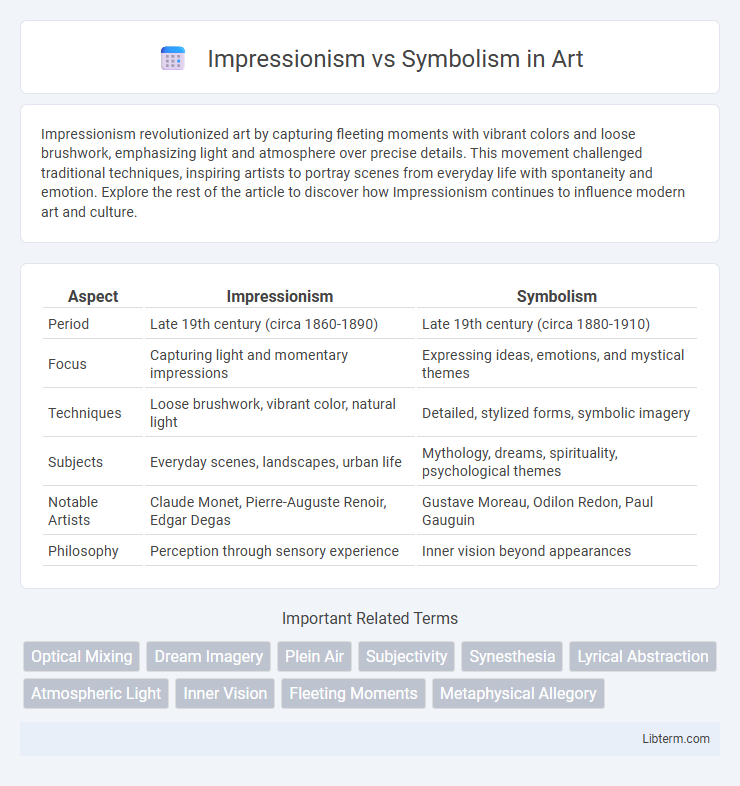Impressionism revolutionized art by capturing fleeting moments with vibrant colors and loose brushwork, emphasizing light and atmosphere over precise details. This movement challenged traditional techniques, inspiring artists to portray scenes from everyday life with spontaneity and emotion. Explore the rest of the article to discover how Impressionism continues to influence modern art and culture.
Table of Comparison
| Aspect | Impressionism | Symbolism |
|---|---|---|
| Period | Late 19th century (circa 1860-1890) | Late 19th century (circa 1880-1910) |
| Focus | Capturing light and momentary impressions | Expressing ideas, emotions, and mystical themes |
| Techniques | Loose brushwork, vibrant color, natural light | Detailed, stylized forms, symbolic imagery |
| Subjects | Everyday scenes, landscapes, urban life | Mythology, dreams, spirituality, psychological themes |
| Notable Artists | Claude Monet, Pierre-Auguste Renoir, Edgar Degas | Gustave Moreau, Odilon Redon, Paul Gauguin |
| Philosophy | Perception through sensory experience | Inner vision beyond appearances |
Introduction to Impressionism and Symbolism
Impressionism emerged in the late 19th century, characterized by its emphasis on capturing light, color, and everyday moments through loose brushwork and spontaneity. Symbolism developed concurrently as a reaction against realism, focusing on conveying emotional experiences and ideas through symbolic imagery and mythological themes. Both movements significantly influenced modern art by challenging traditional representation and exploring new visual languages.
Historical Contexts of Both Movements
Impressionism emerged in the late 19th century as a response to the rapid industrialization and urbanization in France, emphasizing light, color, and everyday scenes to capture fleeting moments. Symbolism developed concurrently as a reaction against the materialism of the era, focusing on mysticism, emotions, and imagination, often portraying dreamlike and allegorical subjects. Both movements reflect the cultural tensions of the late 1800s, with Impressionism aligned to scientific observation and Symbolism to spiritual and psychological exploration.
Key Philosophical Differences
Impressionism emphasizes capturing fleeting moments and sensory impressions through light and color, reflecting a philosophy grounded in direct experience and perception. Symbolism, in contrast, prioritizes conveying deeper metaphysical meanings and emotions by using symbolic imagery, rooted in subjective interpretation and spirituality. These divergent philosophical approaches highlight Impressionism's commitment to observable reality versus Symbolism's exploration of inner truths.
Pioneering Artists and Their Influences
Impressionism, led by pioneering artists like Claude Monet and Pierre-Auguste Renoir, emphasized capturing fleeting light and natural scenes through loose brushwork and vibrant colors, drawing direct inspiration from contemporary urban life and plein-air painting techniques. Symbolism, represented by artists such as Gustave Moreau and Odilon Redon, revolved around expressing inner emotions, dreams, and spirituality, influenced heavily by literary movements and psychological exploration. Both movements shaped modern art by challenging traditional representation, with Impressionism focusing on visual perception and Symbolism delving into metaphorical and mystical themes.
Artistic Techniques and Styles
Impressionism emphasizes capturing light and movement through loose brushwork, vibrant color palettes, and short, quick strokes that depict everyday scenes with a focus on atmosphere and natural light effects. Symbolism prioritizes conveying deeper meanings and emotions using stylized forms, dreamlike imagery, and symbolic motifs often rendered with meticulous detail and muted, often dark, color schemes. While Impressionism seeks to represent external visual reality, Symbolism aims to evoke internal experiences and abstract ideas through poetic and mysterious visuals.
Themes and Subject Matter Explored
Impressionism emphasizes capturing fleeting moments, light, and everyday scenes, often portraying landscapes, urban life, and leisure activities with an emphasis on natural perception. Symbolism explores inner experiences, myths, dreams, and emotions, using symbolic imagery to convey deeper meanings beyond the physical world. While Impressionism focuses on external reality and sensory impressions, Symbolism delves into spirituality, imagination, and the subconscious mind.
Color, Light, and Composition Approaches
Impressionism emphasizes capturing natural light and its transient effects using loose brushstrokes and a vibrant, often pastel color palette to depict outdoor scenes with an emphasis on immediacy and atmosphere. Symbolism, conversely, employs color and composition more subjectively, using darker, richer hues and stylized forms to evoke emotional and mystical meanings beyond literal representation. While Impressionist compositions are typically open and spontaneous to mirror natural perception, Symbolist works often feature more structured, deliberate arrangements to convey symbolic narratives and inner visions.
Reception and Criticism in Their Time
Impressionism faced early criticism for its departure from traditional techniques, with critics mocking its loose brushwork and focus on light and color over precise detail, yet it gradually gained acceptance for its innovative approach to capturing modern life. Symbolism, emerging as a reaction to Impressionism's perceived superficiality, was initially criticized for its obscure themes and emphasis on mysticism and emotion, leading to polarized reception among art critics and the public. Over time, Symbolism was recognized for its influence on modern art movements, while Impressionism became celebrated for revolutionizing visual perception and artistic expression in the late 19th century.
Lasting Impact on Modern Art
Impressionism revolutionized modern art through its emphasis on light, color, and capturing fleeting moments, influencing movements such as Post-Impressionism and Abstract Expressionism. Symbolism contributed a rich layer of emotional depth and mythological themes, shaping Surrealism and early Expressionism by prioritizing subjective experience and imaginative content. Together, these movements expanded the boundaries of artistic expression, laying the foundation for 20th-century art's diverse explorations of perception and meaning.
Conclusion: Legacy and Contemporary Relevance
Impressionism revolutionized art by emphasizing light and color to capture fleeting moments, influencing modern visual culture and photography. Symbolism introduced a deeper, imaginative exploration of themes beyond visible reality, shaping surrealism and contemporary narrative art. Both movements continue to inspire artists by blending sensory experiences with symbolic meaning, enriching contemporary artistic expression and interpretation.
Impressionism Infographic

 libterm.com
libterm.com